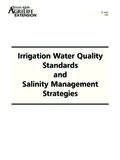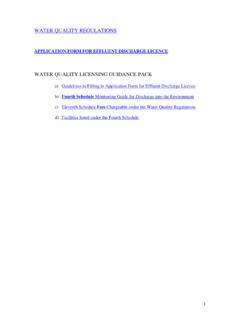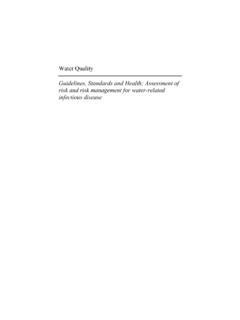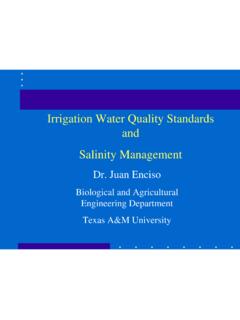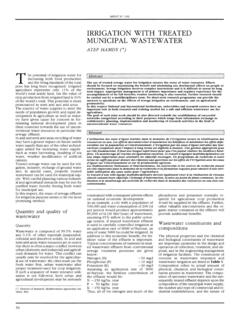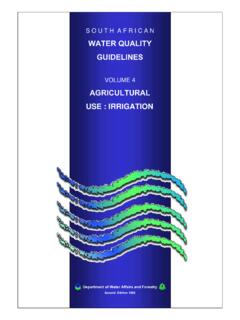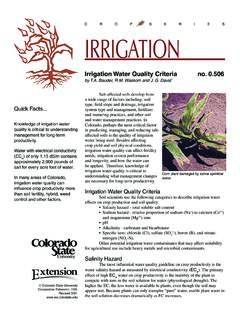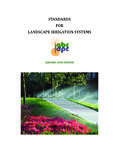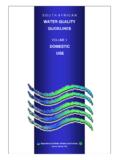Transcription of Irrigation water quality - Colorado State University
1 water quality for Irrigated Agriculture water quality for Irrigated Agriculture ----Salinity/Salinity/SodicitySodicityFo cusFocusTroy Bauder, John Troy Bauder, John StednickStednick, , Timothy Gates, Lorenz SutherlandTimothy Gates, Lorenz SutherlandOverviewzTerminologyzBackgroun dzParameters of concernzImpactszManagementFactors Influencing SalinityGeology: weathering of primary minerals, marine sediments, etcClimate: evaporation exceeds precipitationIrrigation: water with moderate to high TDS or SARW ater table: near soil surfaceHuman activity: mines, production plants, or high urban activitySoil drainage: poorIrrigation water QualityzAll waters used for Irrigation contain varying amount of saltszSalinization of soil and water is inevitable in climates where ET > precipitationzThus, drainage, either natural or artificial is essential to manage saltszKey to sustainable irrigated agriculture in arid/semi-arid climates TerminologyzSalinity- total salt content Electrical Conductivity (ECw) Electrical Conductivity of saturated paste extract (ECeor sat) 1 dS/m = 1 mmho/cm = 1000 mho/cm Total Dissolved Solids (TDS):mg/L or ppmTerminologyzSodicity(sodic) - high sodium content SAR: sodium adsorption ratio SARadj:adjusted SAR ESP: Exchangeable sodium percentage (soil)zpH acidic (< ), basic (> ), alkaline (> )Na, Ca, and Mg concentrations must be expressed as per litermeq/Lmilliequivalents per liter: mg/l atomic wt.
2 Chargeppmparts per milliondS/mdeciSiemens per meter S/cmmicroSiemens per centimetermmho/cmmillimhos per centimeterTDStotal dissolved solidsConversionsComponentTo ConvertMultiply ByTo ObtainWater nutrient or TDSmg/L1ppmWater salinity hazard1 dS/m11 mmho/cmWater salinity hazard1 mmho/cm1,0001 mho/cmWater salinity hazardEC (dS/m) for EC <5 dS/m640 TDS (mg/L) water salinity hazardEC (dS/m) for EC >5 dS/m800 TDS (mg/L) water NO3N, SO4-S, per acre inch of water appliedGeneral Irrigation water EC ClassificationsClasses of waterTDSE lectrical Conductivity(mg/l)<1,0001,000 2,000>2,000(dS/m)*Class 1, Excellent 2, - 3, - 4, - 5, Unsuitable2 *dS/m at 25 C = mmhos/cm1 Leaching needed if drainage needed and sensitive plants will have difficulty obtaining water is a major source of salts for many fieldszFor every 1 ppm there is lbs per acre inch waterzIrrigation water example: Total Dissolved solids (TDS) = 1000 mg/l (EC = dS/m) 1000 mg/l x = 230 lb/acre inch Seasonal Irrigation (24 inches) 230 x 24 inches = 5520 lb salt / acreSalinity ImpactszPlants only transpire "pure" waterzSalts in Irrigation water remain in soil if not leachedSalinity ImpactszPlant Physiological drought Increased osmotic potential of soil Specific ion toxicity Leaf burn Nutrient uptake interferencesOsmotic PotentialOsmotic PotentialAdsorbed WaterCa+2, Na+, Mg+2, K+SO4-2, HCO3-, Cl-, CO3-2 Matric Potential or Matric SuctionSolute PotentialSalinity Impacts to Crop water UseSoil(ec ): barsRoots: - barsLeaves: -15 barsAir: -500 barsSoil @ field capacity, 86 deg.
3 F, 50% RHSoil( ): barsSoil( ): barsBackground ET vs. Salinity 0246810 ECe (dS/m)(b)012345678ET (mm/day)ET = ( + ), r2 = crop ET versus ECemeasured with EM-38s; (Gates et al. 2006).Background - Yield vs. Evapotranspiration0200040006000800010000 1200005101520253035 Evapotranspiration (inches)Yield (lbs/acre)WheatSoybeanCornSunflowerAlfal faSchneekloth et al, 2004 Crop ImpactsForage cropsForage cropsField cropsField cropsVegetablesVegetablesFruitsFruitsSal inity ToleranceMore (dS/m)Yield Impact (%)Impacts to Landscapes/GardenSalinity Impacts are Site SpecificU pstr eam Alfalfa Fi el ds D ownstr eam Alfal fa Fiel ds Downstream Corn Fields0 2 4 6 8 1012141618202224 ECe (dS/m) Crop YieldRelative Yield vs. Salinity(Gates et al 2006) Irrigation water quality Specific Ion Concerns and ToxicitiesSodium (Na+)zSoil sodicity Crusting Reduced infiltration Lower hydraulic conductivity Higher pH impacting nutrient uptake/imbalanceszPlant Stunted plants Toxicity and leaf burn potentialGeneral Sodium Irrigation water ClassificationsSAR valuesSodium hazard of waterComments1-9 LowUse on sodium sensitive crops must be (such as gypsum) and leaching unsuitable for continuous use.
4 26 Very HighGenerally unsuitable for : Actual impacts of SAR to soil/crop system are very site specific and these values should be used as guidelines and SARThe hazard of Irrigation water sodium on soil infiltration mustbe determined from the SAR/EC interaction. As EC increases relative to SAR, infiltration problems are or sprinkler Irrigation with non-saline water on soils previously irrigated with sodic water can increase the infiltration and Westcott, 1985 Point: Irrigating with water with a lower EC than the soil can cause more infiltration problems at high (Cl-)zContributes to ECzEssential in low amountszSensitive crops affected at high concentrationzLeaf burn potential under sprinklerzBurn higher with daytime irrigationChloride tolerance criteriaChloride (ppm)Effect on CropsBelow 70 Generally safe for all plants show tolerant plants show 350 Can cause severe tolerance of selected crops. Listing in order of increasing tolerance: (low tolerance) dry bean, onion, carrot, lettuce, pepper, corn, potato, alfalfa, sudangrass, zucchini squash, wheat, sorghum, sugar beet, barley (high tolerance).
5 Source: Mass (1990) Crop Salt Tolerance. Agricultural Salinity Assessment and Management Manual. Tanji (ed.). ASCE, New York. pp 262-304. Boron (B)zEssential in low amounts (alfalfa)zToxic to sensitive crops (> to ppm)zFertility Sufficient in low concentrationsz24 inches of ppm= lb B / acrepH, Carbonate, and bicarbonate (alkalinity)zpH > HCO3-cause Ca2+& Mg2+to form insoluble minerals leaving exacerbate sodicsoil conditionsNitrate-nitrogen (NO3-N)zFertility issuezCan be significant N source in some basins: S. Platte San Luis Valley ArkansaszGenerally managed with N fertilizer programzShould be credited toward fertilizer ratePlant impacts uptake interferenceszHigh pH affects P, Fe, and Zn availabilityzElevated Na can induce Ca and/or Mg deficiencyColorado Ground water quality Examples Median ValuesDissolved ConstituentHigh PlainsS. Platte AlluvialArkansas AlluvialLaramie-Fox Hills *-------------------- mg / l ---------------------TDS3111,3052, *From: Ground water Atlas of Colorado , Colo.
6 Geological SurveyColorado Surface water quality Examples Dissolved ConstituentLower S. PlatteLowerArkansas**Rio Grande---------- mg / l -----------Calcium30-7045 - 420 5 12 Sodium30 - 635 2 6 Bicarbonate60 120 75 - 740 20 50 Sulfate40 160160 - 790 Chloride20 - 120 10 - 165 < 1,200*~600 -3,60032 60*From: USGS NWIS at Del Norte**Gates, et al, water Report 2 Example water ReportThe common signature of product water is a wide range in salinity and very high sodicityCMB and water quality ?Biogenic methane Primarily sodium : J. Bauder, MSUC hemical Changes in due to Coal Bed Methane Product water When dischargedFor example sodium bicarbonate-rich product water is discharged to a stream: the salt (EC, TDS) concentration of the water will increase the soluble calcium concentration will decrease, and the SAR will (HCO3)2 + Ca CaCO3(calcite or limestone) + Na + H2O + CO21 XSource: J. Bauder, MSUEC and SAR of CBNG produced water were greater than those recommended for Irrigation on the study sitesEC and SAR of the soil saturated paste extract in the 0-30 cm depth for most sites following Irrigation were significantly greater than the controlsIrrigation resulted in a significant accumulation of sodium Results of this study suggest CBNG waters used for Irrigation in northwestern PRB, Wyoming, are generally unsuitable for direct land Chemical Changes Resulting from Irrigation with water Co-Produced with Coalbed Natural GasGirisha K.
7 Ganjugunte, George F. Vance, and Lyle A. King, Journal of Environmental quality , 2005 Management OptionszCrop selectionzIrrigation Management Controlled leaching System adjustmentszSoil Drainage Tillage/compaction Amendments sodicproblems onlyzContinued monitoringDiagnosis Understanding the Problem(s)zSalinity problems are usually present before yield impacts measuredField DiagnosisPotential symptoms white crust on soil surface water stressed plants, species changes leaf tip burn leaf burn poor growth moisture stress crusting or hardsetting low infiltration rate; runoff and erosion dark powdery residue on soil surface stunted plants with leaf margins burned generally, same symptoms as saline soilnutrient deficiencies manifesting as: stunted yellow plants dark green to purplish plantsProblemsaline soilsaline irrigationwatersodic soilsaline-sodic soilhigh pHGeneralized Classification of Salt-Affected SoilsClassificationElectricalConductivit y(dS/m)Sodium AdsorptionRatio (SAR)Soil pHSaline> <13< < >13> > >13< pH< <13> Understanding Salinity ProblemSource, Louis Garcia, CSUzSalinity varies spatially, with depth and with timezRoutine fertility soil sample generally not adequate to fully describe and monitor salinity problemDiagnosis Understanding Salinity ProblemzIrrigation water analysis essential for proper diagnosiszUnderstand changes in source, timeSummaryzMost Colorado Irrigation water contains some level of saltzConcentration and type of salt should direct management adjustmentszUsing saline/sodic Irrigation water can decrease productivity and crop choiceszUsing saline/sodic water will increase cost of production for most cropping systemszSalinity/sodicity impacts are site
